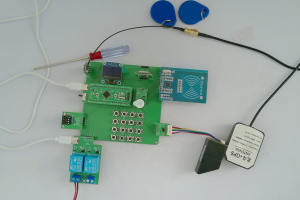设计说明书
总字数:21000+
摘要
在信息安全日益受到重视的当下,手提文件箱作为重要文件和物品的载体,其防盗性能的高低直接关系到信息与财产的安全。传统的机械锁具防盗方式,存在钥匙易丢失、被盗配,以及无法实时监控和远程预警等问题,难以满足现代场景下对文件箱安全防护的高要求。
基于 STM32F103C8T6 单片机的手提文件箱防盗设计,整合了 4*4 矩阵键盘、AS608 指纹模块、RFID 卡模块、AT24C02 存储模块、蜂鸣器、ESP8266 WIFI 模块、继电器(控制磁锁和自毁装置)、OLED 显示屏、GPS + 北斗定位模块等,实现了文件箱的多重防盗保护与智能管理。系统核心功能包括:通过矩阵键盘进行密码输入(0-9 为数字键,为删除键,# 为确定键,A 为电源启动键,B 为重置密码键,C 为添加删除指纹,D 为添加删除卡),其中重置密码需经管理员密码、旧密码、新密码、再次新密码的流程;添加或删除指纹、RFID 卡均需先输入管理员密码;借助 AT24C02 存储密码,实现掉电保存;当输入密码或指纹总错误次数≥3 次时,蜂鸣器报警 30s,同时锁定键盘及指纹模块 1 分钟,并通过 ESP8266 WIFI 模块将 “密码错误次数过多,请速速查看” 的信息发送至手机端;通过继电器控制磁锁,模拟开锁和关锁操作;OLED 显示屏会以号形式显示输入的密码,且输入密码时可在前后加入扰乱码,只要包含正确密码即可验证通过;利用 GPS + 北斗定位模块实时监测文件箱位置,当密码输入错误次数过多时,系统将位置信息通过 WIFI 模块发送到手机,手机端还可控制由继电器操控的自毁功能;此外,通过 WIFI 模块能远程手动控制文件销毁功能,并实时查看文件箱位置信息。
该设计有效提升了手提文件箱的防盗安全性与智能化管理水平,为重要文件和物品的安全防护提供了可靠保障,同时也为同类防盗设备的研发提供了参考,具有较高的实际应用价值。
关键词:STM32F103C8T6;手提文件箱;防盗设计;多重验证;远程控制;定位追踪
ABSTRACT
In an era where information security is increasingly valued, the anti-theft performance of portable file boxes, as carriers of important documents and items, directly relates to the security of information and property. Traditional mechanical lock anti-theft methods have problems such as easy loss or duplication of keys, inability to monitor in real-time and remote early warning, making them difficult to meet the high requirements for the security protection of file boxes in modern scenarios.
The anti-theft design of the portable file box based on the STM32F103C8T6 microcontroller integrates a 4*4 matrix keyboard, AS608 fingerprint module, RFID card module, AT24C02 storage module, buzzer, ESP8266 WIFI module, relays (controlling magnetic locks and self-destruct devices), OLED display, GPS+Beidou positioning module, etc., realizing multiple anti-theft protection and intelligent management of the file box. The core functions of the system include: password input through the matrix keyboard (0-9 as numeric keys, * as the delete key, # as the confirm key, A as the power start key, B as the password reset key, C as the add/delete fingerprint key, D as the add/delete card key). The password reset process requires the administrator password, old password, new password, and re-entering the new password; adding or deleting fingerprints and RFID cards requires entering the administrator password first; using AT24C02 to store passwords to achieve power-off preservation; when the total number of incorrect password or fingerprint inputs is ≥3 times, the buzzer alarms for 30 seconds, and at the same time locks the keyboard and fingerprint module for 1 minute, and sends the message “Too many incorrect password attempts, please check immediately” to the mobile phone through the ESP8266 WIFI module; controlling the magnetic lock through a relay to simulate unlocking and locking operations; the OLED display shows the entered password in the form of *, and when entering the password, disturbance codes can be added before and after, as long as the correct password is included, the verification can pass; using the GPS+Beidou positioning module to monitor the position of the file box in real-time, when there are too many incorrect password inputs, the system sends the position information to the mobile phone through the WIFI module, and the mobile phone can control the self-destruct function controlled by a relay; in addition, the file destruction function can be manually controlled remotely through the WIFI module, and the position information of the file box can be viewed in real-time.
This design effectively improves the anti-theft security and intelligent management level of the portable file box, provides a reliable guarantee for the security protection of important documents and items, and also provides a reference for the research and development of similar anti-theft equipment, with high practical application value.
Keywords: STM32F103C8T6; Portable file box; Anti-theft design; Multiple verification; Remote control; Positioning and tracking
目录
第 1 章 绪论
1.1 研究的目的及意义
1.2 国内外发展情况
1.3 本文主要研究内容
第2章 设计思路与方案论证
2.1 主要元器件选择
2.1.1 主控芯片选择
2.1.2 指纹识别模块选择
2.1.3 RFID 卡模块选择
2.1.4 键盘模块选择
2.1.5 显示模块选择
2.1.6 存储模块选择
2.1.7 通信模块选择
2.1.8 定位模块选择
2.2整体设计方案
第 3 章 硬件设计
3.1 主控电路模块
3.2 指纹识别模块电路
3.3 RFID 卡模块电路
3.4 键盘模块电路
3.5 显示模块电路
3.6 存储模块电路
3.7 通信模块电路
3.8 定位模块电路
3.9 报警模块电路
3.10 继电器模块电路
第4章 系统程序设计
4.1 编程软件介绍
4.2 系统主流程设计
4.3 OLED显示子流程设计
4.4 矩阵键盘子流程设计
4.5 存储模块子流程设计
4.6 RFID模块子流程设计
4.7 指纹模块子流程设计
4.8 WiFi模块子流程设计
第 5 章 仿真测试
5.1 整体仿真测试
5.2 指纹识别模块功能测试
5.3 RFID 卡模块功能测试
5.4 键盘与密码功能测试
5.5 报警与锁定功能测试
5.6 通信功能测试
5.7 定位模块功能测试
第 6 章 实物测试
6.1 整体实物测试
6.2 指纹识别模块功能测试
6.3 RFID 卡模块功能测试
6.4 键盘与密码功能测试
6.5 报警与锁定功能测试
6.6 通信功能测试
6.7 定位模块功能测试
第 7 章 总结与展望
7.1 总结
7.2 展望
致谢
参考文献
附录
附录一:原理图
附录二:PCB
附录三:主程序
购买后可查看具体内容!

